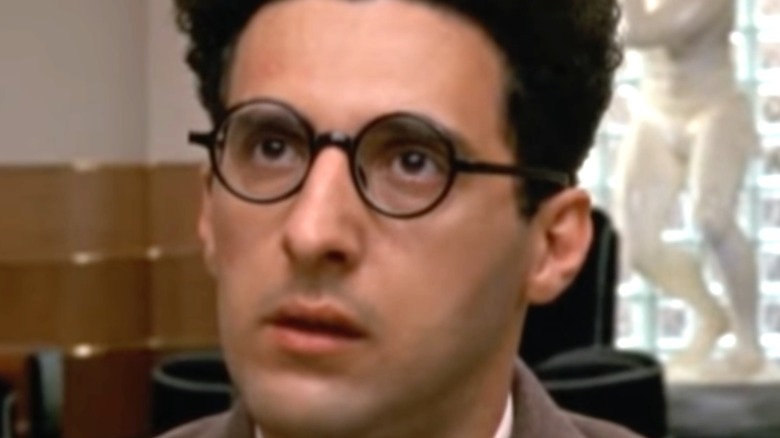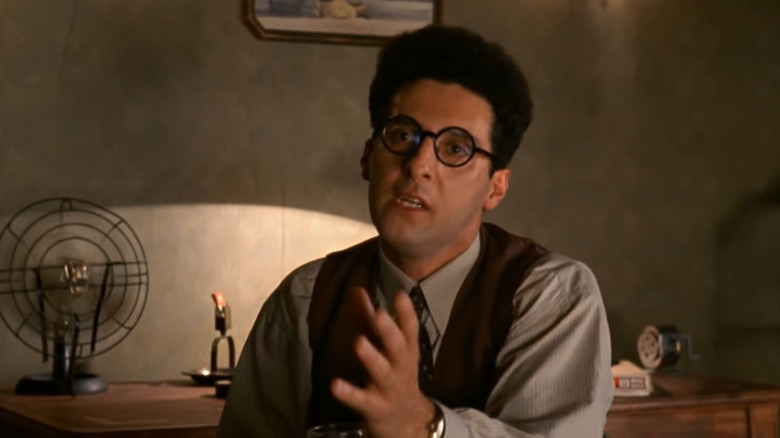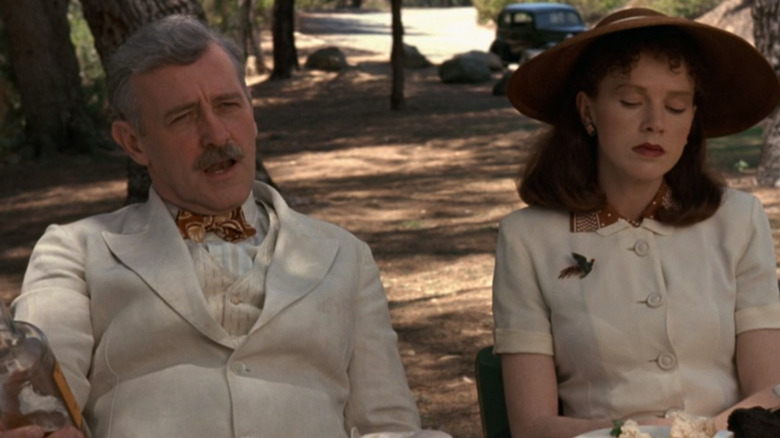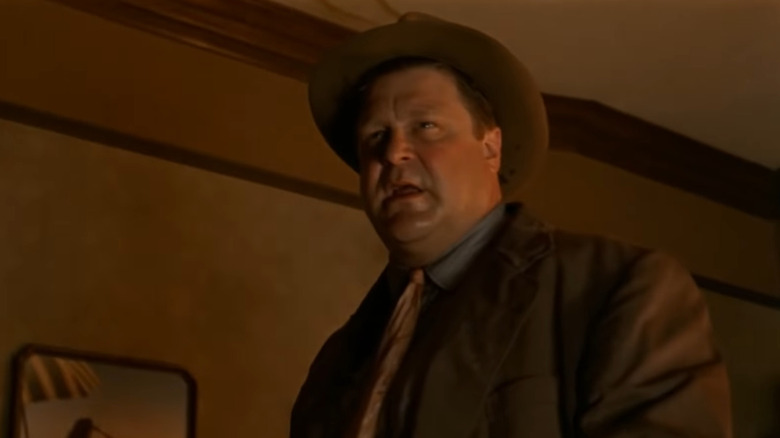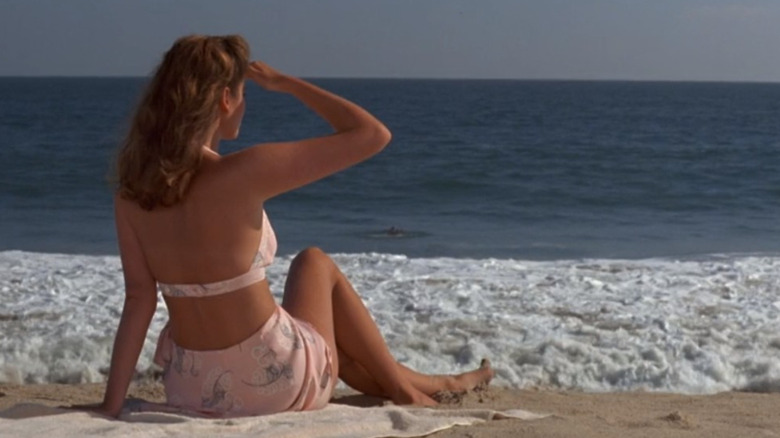The Ending Of Barton Fink Explained
Released in 1991, many consider "Barton Fink" to be the Coen Brothers' first true masterpiece. The film tells the story of a New York playwright who is tasked with coming to Hollywood and writing a wrestling film, only to experience writer's block and make some grueling discoveries along the way. The film was developed by the Coens while dealing with their own form of writer's block as they were making "Miller's Crossing," giving the film a meta quality to it. It would see the duo's first collaboration with cinematographer Roger Deakins. Despite flopping at the box office during its initial release, making only $6 million on a $9 million budget (per Box Office Mojo), it was loved by critics (via Rotten Tomatoes). It would go on to perform a rare sweep at the Cannes Film Festival, winning the Palme d'Or, as well as Best Actor for John Turturro and Best Director. It would also earn three Oscar nominations for best art direction, best costume design, and best supporting actor for Michael Lerner.
Today, the film enjoys a special place in the hearts of film lovers everywhere. Between its pitch-perfect performances, inspired art direction, and lush cinematography, the film is famous for its heavy themes and ambiguous nature that continues to leave viewers in the dark to this day. It certainly isn't a film that will give you answers on a silver platter, but that's what has added to its enduring appeal. That said, let's take a look at the pieces that make "Barton Fink" the mind-bending experience it is and how those pieces affect the ending.
Hell or high writer
Following a successful play in New York, Barton Fink (Turturro) is given the offer to come to Hollywood and write for Jack Lipnick's (Lerner) Capitol Pictures. Despite initially being hesitant as he wants to stay in New York where the "common man" presides, Fink eventually agrees to write the wrestling film. With no knowledge of the subject and lacking inspiration, Fink runs into a major writer's block while stuck in a crummy hotel room. To make it all worse, Lipnick has ridiculously high respect for Fink and adds immense pressure on the writer, expecting nothing short of a masterpiece.
Likely originating from the aforementioned experience of the Coens struggling to write "Miller's Crossing," the relationship between Hollywood and screenwriting is almost depicted as a version of hell. In this scenario, Hollywood would be hell, amplified by Fink's sweltering room and numerous bible verses he reads throughout the film, and the process of screenwriting is an everlasting punishment. It's the Coen Brothers' trademark dark comedy at play. Having a pretentious playwright craft an exploitative B-movie brings a level of self-awareness to itself about the needlessly complicated thought process commonly associated with writers. And Fink's obsession with it — one that blinds him to the needs of others — is what makes him go through this punishment.
Don't hold out on your heroes
In his search for solace, Barton comes across famed writer W.P Mayhew (John Mahoney) while in a restroom. He introduces himself and Mayhew invites him to hang out one day and talk about his work. Throughout the film, Fink learns that Mayhew is, in fact, a raging alcoholic whose secretary, Audrey (Judy Davis), must deal with his abusive tendencies. Fink attempts to comfort Audrey, but ultimately, he only tries to use her to get help with his script, especially after discovering that she ghost-wrote most of Mayhew's work.
Fink's attempts to break out of the typical Hollywood image are reflected in how Mayhew is depicted. Quite literally introduced vomiting in a toilet, Mayhew is shown to be the very thing Fink fears –- a drunken, dishonest writer consumed by the Hollywood system. And while Fink never quite takes on that image, it's clear that his selfish desires outweigh anyone else's issues. This is present when he invites Audrey over one night to help with his script, not caring about the delicate situation she finds herself in dealing with Mayhew. He does offer some level of comfort, but he views his own issues as more prominent and important.
Trusting the common man
Probably the most standout performance in "Barton Fink" is that of John Goodman. He starts off as friendly insurance agent Charlie Meadows, whose big-hearted nature proves endearing to both Barton and the audience. They meet after Fink makes complaints to the hotel staff about noise coming from Meadows' room. But rather than arguing with Fink, Meadows apologizes and offers a listening ear to Fink about his woes. Throughout the film, he imbues Fink with the confidence to keep going. He also comes in handy towards the end, when, following the night with Audrey, Fink finds her brutally murdered in the bed next to him. Mortified, he confides in Meadows and tells his secret. Meadows believes that Fink didn't do anything and takes care of the body for him. Meadows then must leave for New York for a few days, much to Fink's disappointment, but promises to return and leaves Fink a mysterious box.
Following this, Fink learns from two detectives that Meadows is, in fact, a serial killer named Karl "Madman" Mundt who beheads his victims. Fink is suspected to have been a part of Audrey and now Mayhew's murder. Mundt returns and takes out the detectives. During the conflict, he starts a fire in the hotel hallway outside Fink's room. The two proceed to have a conversation, where Mundt breaks down Fink's arrogance before heading back to his room.
Mundt is an essential character in that his inclusion shows just how far away Fink truly is from the world he aims to depict. Despite stating he wants to tell the story of the everyman, Fink constantly brushes off Mundt's attempts at telling him any of his own stories and, once again, uses Mundt as a manner of expelling his own frustrations.
Who's the lady on the beach?
After his script gets rejected by Lerner (who continues to keep him under contract regardless), Fink takes a walk along an empty beach. He still has the package that Mundt gave him. Just then, a woman passes by and stops to make light conversation. As she settles down, Fink asks, "Are you in pictures?" to which she replies, "Don't be silly." She then sits and assumes the exact same pose as a picture of a woman that sat above Fink's writing desk in the hotel.
The film ends with many questions unanswered. We never find out what's in the box, where Audrey or Mayhew's bodies lay, the whereabouts of Mundt, or how Fink's screenwriting endeavors turn out. Rather, we are left to make those decisions for ourselves as an audience. What we are left with is Fink, quite literally separate from his confined quarters, coming across an image that reflects the seemingly mundane work of art he stared at everyday. Is her rejection of being a part of the Hollywood system meant to echo Fink's own deep desires? Is she the wake-up call Fink needs to see the true beauty of the "common man?" There are endless ways this final scene can be interpreted, but it nevertheless comes off as a perfectly enigmatic way to close the curtains on this surreal experience.
